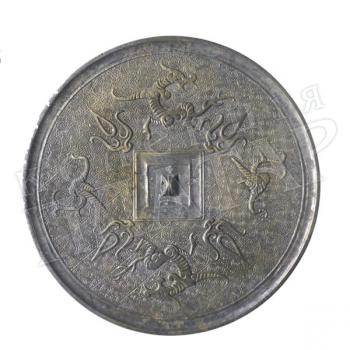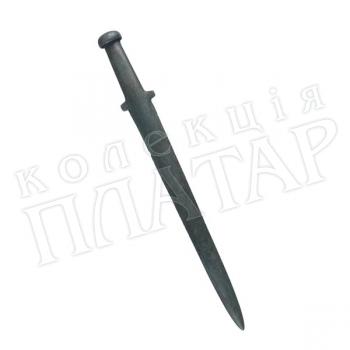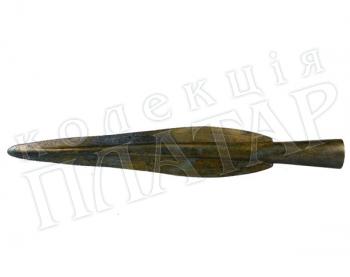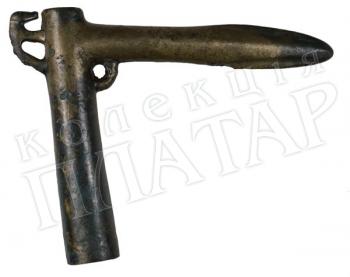Mirror as a round disc with smooth and shiny front and back side, decorated with diaglyphic ornament in a way of many figured zoomorphic composition from mythological creatures. In the center of backside there is an ear.
Early Iron Age. Cimmerians, Scythians, Sarmatians
Ancient Greeks called the tribes that lived on the territory of modern Ukraine from VII B.C. to III century by the common name the „Scythians“. According to the legend passed on by Herodotus „father of history“, Scythians came from beyond the Volga and conquered the land of the Cimmerians. Afterwards pursuing them the Scythian bands reached the Near East and for about 30 years they devastated the Urarta Kingdom, Assyria, Mede, reached Egypt. Having come back to the Southern Black sea region the Scythians met an unexpected enemy. According to Herodotus their wives copulated with slaves during their absence. Now, for the reason that they were afraid of the anger of their husbands the Scythian women sent their slaves sons against the Scythians and they did not allow them to come back home. Then one of their leaders proposed to fight with slave descendents not like with equal and with arms but like with the slaves taking the whips. As a result the rebels ran away and the Scythians came back their land. Scientists believe that in such a form the stories about Scythian conquering of modern Ukrainian wooden steppe lands inhabited by non-Scythian tribes were kept.
In VI century B.C. Scythia was already a powerful political and military union.
In IV century B.C. Scythia achieved its political and economic golden age. According to Herodotus, ethnic and political leadership belonged to Scythian Kings who considered all the other people their slaves. Scythian nomads lived in the steppe. Scythian farmers lived to the South from them. They grew wheat and sold it. It is considered that they like many others as well as Nervs, Gelons, Agaphirs, Budins and other tribes described by Herodotus were of non-Scythian origin but were in political dependency from nomadic Scythians. One of the famous Scythian Kings was Atey 339 B.C. When he was 90 years old he defeated the father of Alexander the Great — Philip — and it was the beginning of the end of Scythia.
In the III century B.C. Scythia faced new challenges. Drought and severe winters that happened year after year resulted in ecological crisis.Late Scythian union appeared known from the works of Strabona by Scythia Minor. But in the ancient and medieval literature and historic tradition the term “Scythians” became for a long period of time the common name for barbarian population of the Northern Black sea region and a symbol of unconquerable destructive power.
Original and unique phenomenon of the world culture is Scythian animal style. The items of decorative art made in this style (as usual from gild and bronze) created by
the Scythians themselves and Greek artists by order. Following from the name the main in the system of this style images was the image of animals. Herbivorous animals (deer, bull, horse, sheep and so on) symbolized kind and earthly origins. Wild (lion, panther, tiger, and wolf) and fantastic (griffin) flesh eater, eagles and snakes symbolized evil afterworld forces. The struggle between good and evil were depicted in the art of animal style by the scenes of “laceration” — the attacks of carnivores and griffin at herbivorous animals. Archaic Scythian animal image is characterized by innocence of images, animal figures are depicted in original manner but monolithic. Starting from V century B.C. narrative drawing of animal style is complicated the animal images are entwined into ornamental compositions and become their part. Big popularity received the method of that part of the animals imaging that symbolizes their main qualities: horse or elk hoofs, deer horns, predator jaws or tush, eye or eagle beak. In this style the bronze and golden metal plates of bridle sets, adornment for shields and brigandine, were sewed on plates. In IV century B.C. Scythian art incurred the great influence of ancient art. Greek artists who worked for Scythians order readily depicted the images of people and animals creating the style of “ethnographic realism” in Scythian art. Anthropomorphous images of gods and heroes appeared, in the Scythian tombs there started more often appear imported Macedonian and Fessalian things.
The set of Cimmerian old things at the exhibition is one of the most famous and include a series of first class rarities. In the epoch of Cimmerians it is closely connected such unique findings like Lubny treasure and golden hryvnia as well as military accessories and the things of bards. Lubny treasure includes bronze arming and dishes. This nearly 3000 years old treasure is actually a “collection in collection” because it has collected the things made in different parts of Asia and Europe in it – from Lake Baikal to the Balkan Peninsula and the Rhine valley. It belonged probably to one of the Cimmerians or other steppe owners and is the evidence of routes of its military campaigns and long life spent in battles with states and tribes of the ancient world.












